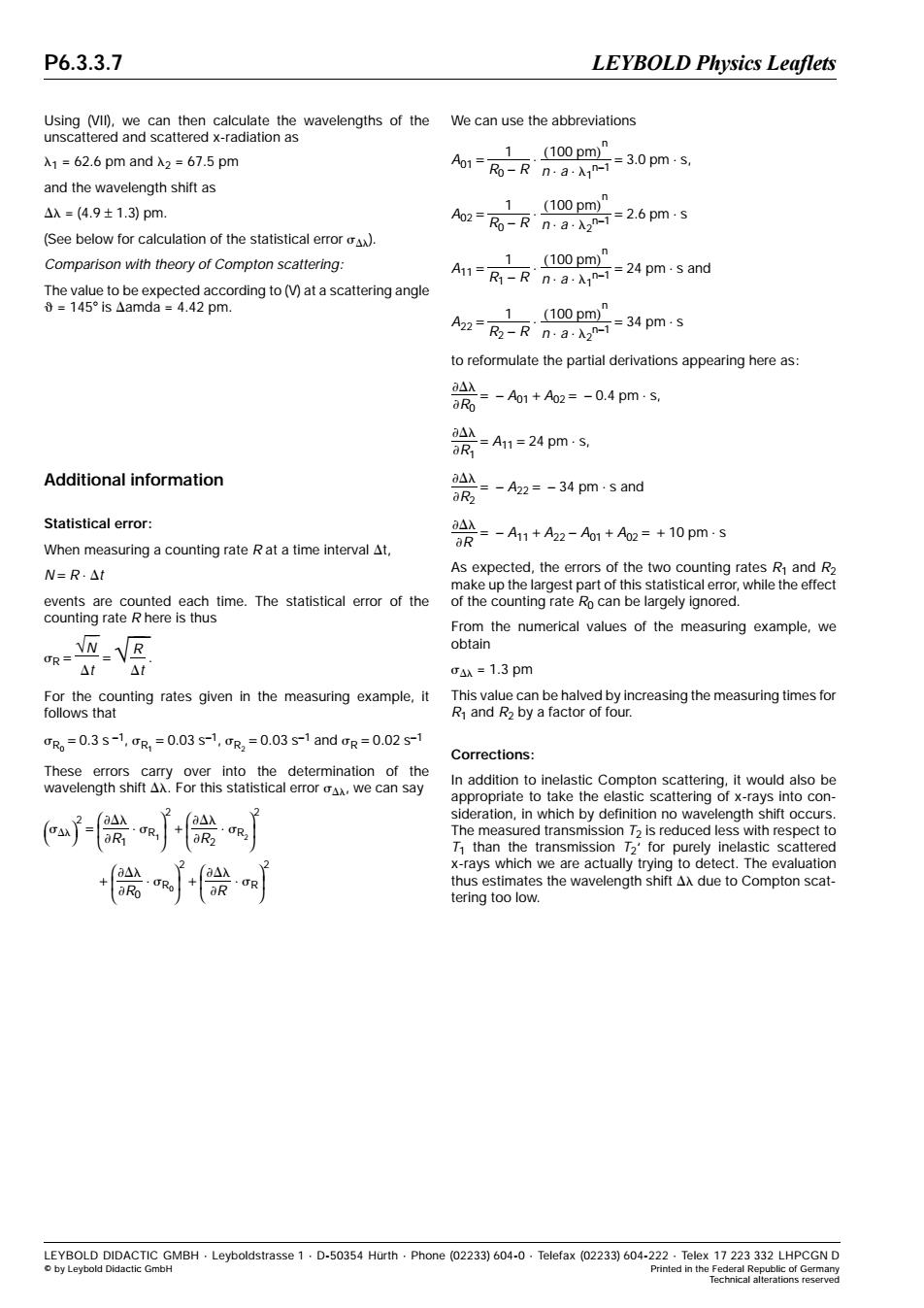正在加载图片...

P6.3.3.7 LEYBOLD Physics Leaflets Using (VIl),we can then calculate the wavelengths of the We can use the abbreviations unscattered and scattered x-radiation as λ1=62.6 pm and入2=67.5pm _1_.(100pm)” Ao3.0 pms. and the wavelength shift as △λ=(4.9±1.3)pm. 1.(100pm)" Ao222.6 pms (See below for calculation of the statistical error). Comparison with theory of Compton scattering: 1.100pm) A1=R1-Rn:=24 pm.s and The value to be expected according to(V)at a scattering angle 8=145°is△amda=4.42pm. 1,100pm)」 A234 pm.s to reformulate the partial derivations appearing here as: 22=-A01+Ao2=-0.4pm·s, aRo A=A1=24pm·5, aR Additional information aAX=-A22=-34 pm.s and aR2 Statistical error: =-A11+A22-Ao1+Ao2=+10pm:s When measuring a counting rate R at a time interval At, aR N=R.△t As expected,the errors of the two counting rates R and R2 make up the largest part of this statistical error,while the effect events are counted each time.The statistical error of the of the counting rate Ro can be largely ignored. counting rate R here is thus From the numerical values of the measuring example,we -YN-VR obtain 0R At At CA 1.3 pm For the counting rates given in the measuring example,it This value can be halved by increasing the measuring times for follows that R and R2 by a factor of four. R=0.3s-1,R,=0.03s-1,R=0.03s1 and oR=0.02s1 Corrections: These errors carry over into the determination of the wavelength shift AX.For this statistical error x,we can say In addition to inelastic Compton scattering,it would also be appropriate to take the elastic scattering of x-rays into con- j器j钱j sideration,in which by definition no wavelength shift occurs. The measured transmission T2 is reduced less with respect to 7 than the transmission 72'for purely inelastic scattered 器j器j x-rays which we are actually trying to detect.The evaluation thus estimates the wavelength shift AX due to Compton scat- tering too low. LEYBOLD DIDACTIC GMBH.Leyboldstrasse 1.D-50354 Hurth.Phone (02233)604-0.Telefax(02233)604-222.Telex 17 223 332 LHPCGN D by Leybold Didactic GmbH Printed in the Federal Republic of Germany Technical alterations reservedUsing (VII), we can then calculate the wavelengths of the unscattered and scattered x-radiation as l1 = 62.6 pm and l2 = 67.5 pm and the wavelength shift as Dl = (4.9 ± 1.3) pm. (See below for calculation of the statistical error sDl). Comparison with theory of Compton scattering: The value to be expected according to (V) at a scattering angle q = 1458 is Damda = 4.42 pm. Additional information Statistical error: When measuring a counting rate R at a time interval Dt, N = R ⋅ Dt events are counted each time. The statistical error of the counting rate R here is thus sR = √N Dt = √R Dt . For the counting rates given in the measuring example, it follows that sR0 = 0.3 s −1, sR1 = 0.03 s−1, sR2 = 0.03 s−1 and sR = 0.02 s−1 These errors carry over into the determination of the wavelength shift Dl. For this statistical error sDl, we can say sDl 2 = Dl R1 ⋅ sR1 2 + Dl R2 ⋅ sR2 2 + Dl R0 ⋅ sR0 2 + Dl R ⋅ sR 2 We can use the abbreviations A01 = 1 R0 − R ⋅ (100 pm) n n ⋅ a ⋅ l1 n−1 = 3.0 pm ⋅ s, A02 = 1 R0 − R ⋅ (100 pm) n n ⋅ a ⋅ l2 n−1 = 2.6 pm ⋅ s A11 = 1 R1 − R ⋅ (100 pm) n n ⋅ a ⋅ l1 n−1 = 24 pm ⋅ s and A22 = 1 R2 − R ⋅ (100 pm) n n ⋅ a ⋅ l2 n−1 = 34 pm ⋅ s to reformulate the partial derivations appearing here as: Dl R0 = − A01 + A02 = − 0.4 pm ⋅ s, Dl R1 = A11 = 24 pm ⋅ s, Dl R2 = − A22 = − 34 pm ⋅ s and Dl R = − A11 + A22 − A01 + A02 = + 10 pm ⋅ s As expected, the errors of the two counting rates R1 and R2 make up the largest part of this statistical error, while the effect of the counting rate R0 can be largely ignored. From the numerical values of the measuring example, we obtain sDl = 1.3 pm This value can be halved by increasing the measuring times for R1 and R2 by a factor of four. Corrections: In addition to inelastic Compton scattering, it would also be appropriate to take the elastic scattering of x-rays into consideration, in which by definition no wavelength shift occurs. The measured transmission T2 is reduced less with respect to T1 than the transmission T2‘ for purely inelastic scattered x-rays which we are actually trying to detect. The evaluation thus estimates the wavelength shift Dl due to Compton scattering too low. LEYBOLD DIDACTIC GMBH ⋅ Leyboldstrasse 1 ⋅ D-50354 Hürth ⋅ Phone (02233) 604-0 ⋅ Telefax (02233) 604-222 ⋅ Telex 17 223 332 LHPCGN D © by Leybold Didactic GmbH Printed in the Federal Republic of Germany Technical alterations reserved P6.3.3.7 LEYBOLD Physics Leaflets